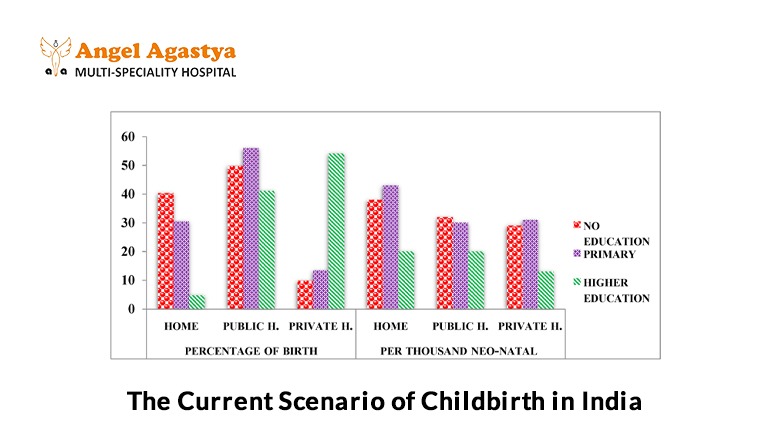Your Guide to Gentle Labour with Fewer Medical Steps in India
Giving birth doesn’t have to feel rushed, clinical or out of your control. Many Indian moms are now choosing gentle labour with fewer medical steps; a calmer, more respectful way to welcome their baby. It’s about trusting your body, making informed choices, and receiving care that supports you, not overrides you. Here’s how to navigate your options and make it happen.

Introduction
Bringing a new life into this world is one of the most beautiful journeys you will ever experience. In India, childbirth has always been a mix of old traditions and new medical science. Today, many parents are asking an important question: “Can childbirth be more natural, gentle, and less medicalized?” The good news is, yes! It can be!
Gentle labour, where we let your body work naturally and only use medical steps when truly needed, is becoming more popular across India. More mothers and families now want a calm, safe and respectful birthing experience, one that honors the mother’s strength and nature’s rhythm.
With the right preparation, a supportive team and trust in your body’s natural strength, you can experience a safe, calm, and empowering birth. Gentle labour with fewer medical steps is truly possible in India. Medical help will always be there if needed, but the focus remains on respecting your natural journey.
Understanding Gentle Labour with Fewer Medical Steps
Gentle labour is about honoring the mother’s intuition. It’s about creating a space where she feels safe, respected and in control of her own body. It’s about minimizing fear and maximizing trust in her innate ability to birth.

Gentle labour is not about being ‘anti-medicine.’ It’s about using medicine wisely and respectfully. Safety is always the priority. India has rich traditions of community supporting gentle labour and honoring mother’s emotional needs.
So, what are possible routines for a mother desiring gentle labour?
1. Avoiding Routine Medical Procedures
This doesn’t mean skipping medical care, it means avoiding what’s not necessary. For example:
- No routine IV drips unless needed for hydration or medications.
- Using a fetal Doppler off and on, instead of attaching you to continuous monitors if your pregnancy is low-risk
- No automatic episiotomy (a cut near the vaginal opening), instead, we wait and support natural stretching.
2. Focusing on Natural Ways to Handle Pain
Gentle labour encourages comfort techniques first:
- Soaking in a warm water tub or taking a shower.
- Walking, sitting on a birthing ball, or squatting which use gravity to help labour progress.
- Gentle massage, focused breathing and even imagining a calm place.
Pain relief options like epidurals are still available but only if you feel the need.
3. Letting Labour Begin on Its Own
Unless there’s a medical reason, we don’t rush to induce labour.
- No early inductions without cause.
- No breaking the water bag unless it helps labour progress naturally.
4. Empowering the Mother
You are the center of your birth experience. That means:
- Your choices, comfort and instincts are respected.
- Your care team supports you, listens to you and makes you feel safe and confident.
5. The Rewards
Women who choose gentle labour with fewer medical steps often say they feel:
- Deeply connected to their birthing journey.
- More confident and in control.
- Quicker to recover.
- Closer to their baby right after birth.
Remember, gentle doesn’t mean passive. It means mindfulness. With the right support, a trusting environment and informed decisions, your birth can be both safe and soulful.
The Current Scenario of Childbirth in India
India’s maternity care has evolved rapidly. A majority of deliveries now happen in hospitals which is a big shift from home births just two generations ago. This has surely helped reduce maternal and infant mortality in many parts. However, it has also led to more medicalized childbirth practices, prompting a growing interest in gentle labour with fewer medical steps as expecting mothers seek a more balanced and natural birthing experience

Common Medical Interventions in Indian Hospitals
- IV drips given as soon as you’re admitted.
- Continuous fetal monitoring for everyone.
- Early administration of epidurals.
- Episiotomies are being too common.
- Induced labour (with drugs like Pitocin) even when not urgent.
But we know India is Diverse
Practices differ widely:
- Public vs. Private Hospitals: Resources, training and protocols can be very different.
- Urban vs. Rural: Some rural hospitals may actually use fewer interventions simply due to lack of resources.
- Provider to Provider: Your birth experience can change dramatically based on who your doctor is.
While national guidelines exist, their implementation can vary significantly across different regions and providers.
Challenges to Gentle Labour with Fewer Medical Steps
While gentle labour with fewer medical steps is ideal for many mothers, achieving it in the Indian context isn’t always easy. As a gynecologist, I’ve seen both progress and roadblocks. Let’s look at the real-life challenges:

1. Provider Mindset
Medical training in India often focuses on “managing labour,” not supporting the natural process.
- Doctors are taught to act quickly if labour slows down, even when it may just need more time.
- As many doctors tell patients, “We’re trained to act quickly, not wait.” It’s not because they don’t care, it’s just how the system works, focusing more on control and safety than trusting the natural flow of the body.
2. Lack of Birthing Infrastructure
Even well-known hospitals may not be built to support gentle birth practices.
- Water tubs or warm showers aren’t available in most labour wards.
- Birthing rooms may be cramped, with limited space to walk or change positions.
- Labouring women are often asked to lie flat on their backs, which is not the most natural or comfortable position. In contrast, gentle labour with fewer medical steps encourages freedom of movement and upright positions that support the body’s natural rhythm. Public hospitals, while doing their best, are often overcrowded and understaffed, making personalized care and such gentle approaches difficult to provide.
3. Cultural Norms and Expectations
In Indian families, labour is often seen as something painful that must be “handled medically.”
- Family elders may insist on epidurals or fast-tracking labour, not knowing about alternative comfort methods.
- Media and films show childbirth as an emergency filled with screams and panic, which adds fear and mistrust.
4. Lack of Awareness Among Expecting Parents
Many couples don’t know their options:
- That they can decline unnecessary procedures.
- That doulas, childbirth educators and midwives are available in some Indian cities.
- What questions to ask during doctor visits to make informed decisions.
5. Communication Gaps
This is perhaps the biggest challenge.
- Many women feel shy or scared to speak up in front of doctors, especially in large, busy hospitals.
- Language barriers, gender dynamics and power gaps often leave expectant mothers out of their own birth planning.
Overcoming these obstacles requires awareness, respectful care, and a shift in mindset among families and care providers. The goal is to find a balance where gentle labour becomes a respected and supported choice, not to reject medical assistance.
The Growing Movement Towards Gentle Birth
Despite the challenges, more Indian parents are choosing gentle birth, driven by awareness, trust, and preparation. Even within our current healthcare system, it is possible with the right support and planning leading to gentle labour with fewer medical steps.

Here are some positive developments:
- Birth Centers: Cities like Bengaluru, Hyderabad, Delhi, and Pune now have private birth centers focused on natural birthing. These centers offer a calm, home-like environment with personalized attention, supporting gentle labour.
- Home Births: Though less common, some low-risk mothers opt for home births with trained midwives. This can be a safe option with thorough research, experienced professionals, and proximity to a hospital for emergencies.
- Supportive Hospitals: Not all hospitals are the same. It’s important to ask questions during antenatal visits, such as:
- “Will I be allowed to move during labour?”
- “Do you routinely induce labour?”
- “What is your episiotomy rate?”
- Some hospitals and doctors are receptive to gentle labour practices; you need to find them.
- Doulas: Doulas are trained professionals offering emotional and physical support during birth. They are increasingly available in cities like Delhi, Mumbai, Chennai, and Kochi, helping parents feel more confident and heard.
- Childbirth Education: Resources like Lamaze, prenatal yoga, relaxation workshops, and hypnobirthing classes are becoming more accessible. These prepare both mothers and their partners, fostering an informed support system.
- Birth Plans: A birth plan doesn’t have to be rigid. Writing down preferences for pain relief, movement, privacy, and immediate skin-to-skin contact can facilitate communication with your doctor.
- Communication: Open communication is crucial. Always inquire before any intervention with a simple question like, “Is this necessary right now?”.
- Midwives: India is witnessing a growth in professional midwives trained to international standards. Their philosophy centers on respecting the mother, following nature’s cues, and providing gentle support during labour.
Gentle labour with fewer medical steps isn’t about inaction; it’s about offering only the necessary care with respect and mindfulness, allowing the birthing process to unfold naturally.
Conclusion
Childbirth practices are gradually changing, towards gentle labour that honors the mother’s intuition, creates a safe and respectful space, and fosters trust in her natural ability to birth. While challenges remain, increasing awareness, supportive environments, and informed choices are empowering more Indian parents to approach birth with confidence and calm. As families advocate for respectful care and trust the natural process, healthcare providers are responding with more mindful and respectful practices.
Remember, your body possesses innate wisdom. With proper preparation, gentle support, and belief in your inner strength, a smooth, respectful and empowering birth is possible. You are not alone; support and awareness around gentle labour with fewer medical steps are expanding. You are part of a quiet revolution, one calm and confident birth at a time.
FAQs – Gentle Labour with Fewer Medical Steps in India
1. Is gentle labour safe for all women?
Gentle labour is best suited for low-risk pregnancies. However, even in higher-risk cases, elements of a gentle approach (like respectful care, movement and non-drug pain relief) can still be used with medical support.
2. Are doulas available in India?
Yes! Especially in metros like Mumbai, Bangalore and Delhi. Many are trained and certified under international programs.
3. Can I have a gentle labour in a government hospital?
It depends. While many public hospitals are resource-limited, some now support birthing positions, avoid routine interventions and allow doulas or birth companions.
4. What’s the cost difference between a hospital birth and birth center?
Birth centers may be slightly more expensive than public hospitals but usually more affordable than high-end private hospitals.
5. Will insurance cover a birth center or home birth?
This depends on the provider. Many Indian insurance plans now cover maternity care, but check if non-hospital births are included.
6. What questions should I ask my doctor to know if they support gentle birth?
Ask about their views on epidurals, induction, movement during labour, doulas and routine procedures like episiotomies. These conversations can help you understand whether their approach aligns with your desire for gentle labour with fewer medical steps.
7. Can I avoid an episiotomy?
Yes. In many cases, with perineal massage and gradual pushing, it’s avoidable. But it’s best to discuss this in advance with your provider.
8. What is the role of my husband/partner during gentle labour?
Partners can offer emotional support, help with pain relief techniques, advocate for your preferences and share the beautiful journey of birth.
9. Are there any natural pain relief methods that really work?
Absolutely! breathing, warm water, movement, massage and music therapy have helped countless Indian mothers manage pain naturally.
10. What if something goes wrong? Can gentle labour adapt to emergencies?
Yes. Gentle labour with fewer medical steps doesn’t mean ignoring medical help. It simply means intervening only when necessary and doing so respectfully, keeping the birthing person’s comfort and dignity in mind.

